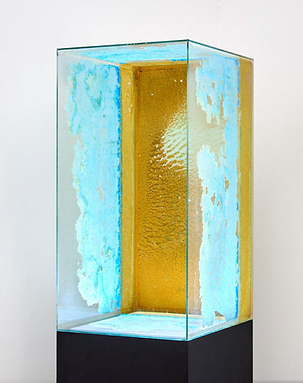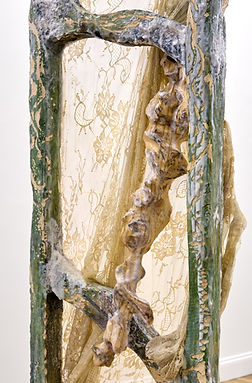
Slow Horror as a Way Back to Our Ability to Care
Written by Peiyue Wu, August 11, 2025
Installation view of Fainting by Connor Sen Warnick. 2025. Photo by Marc Tatti.
“Horror and fear are not the same...”
I went to see No Footsteps Return straight from the hospital. That day, a friend got into a severe car accident and was in the ICU. When I arrived, she was asleep, deeply, impossibly still, her body threaded with wires that tracked her heart rate and other vital signs. The monitors pulsed softly, an irregular chorus of beeps and waves.
The ICU was not the chaotic emergency room I had imagined. It was one of the quietest spaces I have ever entered. Her face carried no visible wounds, the violence of the crash hidden beneath the skin. Doctors spoke in low voices about head trauma, CT scans scheduled throughout the day. Standing beside her, I could not ask what had happened, and perhaps she herself did not know. I wondered what she was dreaming, what her last memory before the impact might have been.
Hours later, I found myself in front of Connor Sen Warnick’s Fainting, the centerpiece of No Footsteps Return. The work is a degraded videotape recorded on Hi8, processed magnetically, then played on a small, old television set on gray bricks. The footage destabilizes before your eyes, turning ordinary scenes into a strange, bodily dizziness, as if the ground is about to give way. Watching it, I felt it was the closest I could come to imagining my friend’s last moments of consciousness, the split second when the world tilts into something unrecognizable, when the body slips into another state and can no longer narrate its own story.
Curated by Chiarina Chen, No Footsteps Return resists the spectacle of horror. In a time when war images, disasters, and apocalyptic headlines scroll endlessly across our feeds, we have grown numb to fear, disconnected from our own bodies and overwhelmed into inaction.
Chen instead wants to explore the concept of “slow horror,” a haunting but meditative aesthetic that reawakens the body and restores a sense of agency in a world saturated with distant catastrophes.
“Horror and fear are not the same,” Chen said. “Fear makes you want to run quickly, but horror makes you stop. You begin to ask a lot of questions within horror. What happened? Why am I feeling this? What is changing?”

Itziar Barrio. was on low. 2023. Concrete, spandex, rubber, lighting filters, hardware,epoxy resin, Arduino, motor, custom circuit board,led lights, electrical pipes and Laura Forlano’s insulin pump alert data. Photo by Marc Tatti.

Phoebus Osborne. Ursula. 2022. Glass aquarium, rust, copper sulfate,black pedestal, speaker with sound, LED panel. Photo by Marc Tatti.

Echo Youyi Yan. Screen. 2025. Pine, Douglas fir, resin, lace tablecloth, metal, papier-mâché, epoxy clay, salt. Photo by Marc Tatti.
Although the artists featured in the show work with very different materials and themes, Chen finds a common thread. They are all exploring states of dissolution, whether through the experiences of immigrants, trans people, or those living with disability. “They all share a kind of monstrosity, a state of survival in darkness,” Chen said.
My favorite piece in the show is the most unassuming one, was on low by Itziar Barrio. It rose and fell with an almost imperceptible rhythm, its movements driven by data from the insulin pump of Laura Forlano, Itziar’s creative collaborator. There is a chilling intimacy in knowing that survival can be tethered to a device. It is comforting in its constancy and unsettling in its control. As Chen put it, “As a disabled person, you constantly rely on technology that is itself flawed and somewhat outcast. You have to keep correcting the robot or AI, always training it, so progress feels like moving forward with a limp.”
From there I drifted toward Echo Youyi Yan’s Screen, which at first looked like a decorative folding screen. But at its base, human feet began to emerge. The work examines how discipline and violence can manifest in the setting of a home. Chen referred to Ian McEwan’s novella First Love, Last Rites, in which a husband folds his wife into furniture, silencing her forever.
Across the room, Phoebus Osborne’s Usula shimmered like something alive. It is a glass tank encrusted with crystalline copper, the result of a failed electroplating process. The mineral growth becomes a queer mutation, a form pressing against the boundaries of the human and reaching for another kind of body.
Almost like an ending mark, Enrique Garcia’s photographic installation Navel (Zócalo) contains a quiet yet potent sense of dread. It juxtaposes photographs of colonial plazas in Mexico, now overtaken by trees, with indigenous artifacts gathered from those same sites. Together they act as material witnesses to histories that have been erased. The work carries a haunting charge that fuses the daily with the violent.
Before I left the show, Chen told me, almost playfully, that if the exhibition gave me a nightmare, it stirred some buried anxiety in my subconscious, I must tell her. She said she would be deeply flattered.

Enrique Garcia. Navel (Zócalo). 2022. Dye-sublimation prints on aluminum, metal parts, earring, wire, cedar frame. Photo by Marc Tatti.
No Footsteps Return
Curated by Chiarina Chen
July 11 to August 16, 2025
RAIN RAIN Gallery
110 Lafayette St, Suite 201, New York NY 10013
Featuring work by Itziar Barrio, Enrique Garcia, Kosuke Kawahara, Phoebus Osborne, Tiina Pyykkinen, Frank Wang Yefeng, Connor Sen Warnick, and Echo Youyi Yan.
Peiyue Wu is an art writer and journalist based in New York City. She holds a Master's degree in Art History from the Institute of Fine Art at NYU. Beyond art, she also writes about China tech and business, with a keen interest in how they are reshaping labor relations, social norms, and the humanities. In 2023, she secured the Society of Publishers in Asia (SOPA) awards in two categories: Excellence in Business Reporting and Excellence in Explanatory Reporting. In 2024, she won 2023 Best in Business Awards (SABEW) in the retail category. Most recently, she received an Honorable Mention in the 2024 Asian American Journalists Association (AAJA) Excellence in Arts & Culture/Entertainment Reporting.
